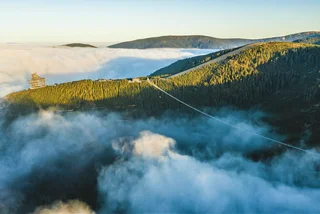When the bridges in Prague were assessed in 2018, it seemed likely that the Libeň Bridge would be torn down due to its poor condition. Architecture fans and local residents, though, rallied to save it.
Now concept sketches of what the bridge and the surrounding area will look like after renovation have been released.
The spaces under the arches and around the bridge will house a skate park, cafes, shops, and new approaches to the water. Design work and preparatory work in the field are currently underway. Construction should begin in 2024 and last two years.
The Libeň Bridge (Libeňský most), which spans the Vltava river and links Prague 7 and Prague 8, was found to be in an emergency condition, the worst structural rating, after an examination in January 2018. It was temporarily closed to cars and trams for two months until it could be supported from underneath.

The concrete Libeň Bridge (Libeňský most) was designed by architects Pavel Janák and František Mencl, and it opened on April 29, 1928, for the 10th anniversary of Czechoslovakia. It is a unique example of Cubist architecture style applied to a bridge, which is why many people supported preserving it rather than replacing it.
“The renovation of Libeňský most will be fine-tuned to the last detail. Not only the bridge but also its surroundings and the spaces in the arches will be transformed beyond recognition. It's great to see how the project is progressing,” Prague Deputy Mayor Adam Scheinherr said on Facebook.
“We diagnosed the entire structure of the bridge, approved the reconstruction project, made a tender for a contractor, signed a contract, and are continuing. We are looking for every opportunity to brush up the old beauty of the Cubist construction of architect Pavel Janák and its surroundings,” he added.
The arch structures over the Vltava will be preserved. The arches will connect with new bridge elements based on sketches by Janák. These have been designed in detail.
“We will supplement the new bridge parts with barrier-free ramps on Rohanský ostrov, which will become a beautiful park in the future. From the Libeň Bridge, we can reach it comfortably on foot, with a stroller, or a bicycle,” Scheinherr said.
The project has been designed to minimize the impact on the community while the renovations are taking place. Construction was supposed to last three years, but it has been reduced to two.
Pedestrians and cyclists will be able to cross the river on a temporary footbridge while construction is taking place. Trams will come up to the edge of the bridge on both sides.

The bridge, which has been in place for over 90 years, has had a number of name changes. It was originally called Masarykův most and was called Baxův most in 1939 and ’40, and then Libeňský most from 1940 to ’45, then Baxův most again from 1945 to ’52. It was Stalingradský most from 1952 to ’62 and then Libeňský most since then.
Concern for the condition of the city’s bridges arose after the footbridge in Troja collapsed on Dec. 2, 2017, injuring four people, two seriously. The footbridge linked Stromovka park with the Troja Chateau and Prague Zoo. It has since been replaced with a new footbridge. A survey in early 2018 found that almost one-fifth of 700 bridges in Prague are in poor, very poor, or emergency condition.
The city’s busiest bridge, Barrandovský most, is also currently under renovation. In addition, a new bridge is planned to connect Prague 4 and 5. It is currently called Dvorecký most but could be renamed to honor former U.S. Secretary of State Madeleine Albright.












 Reading time: 3 minutes
Reading time: 3 minutes 


























